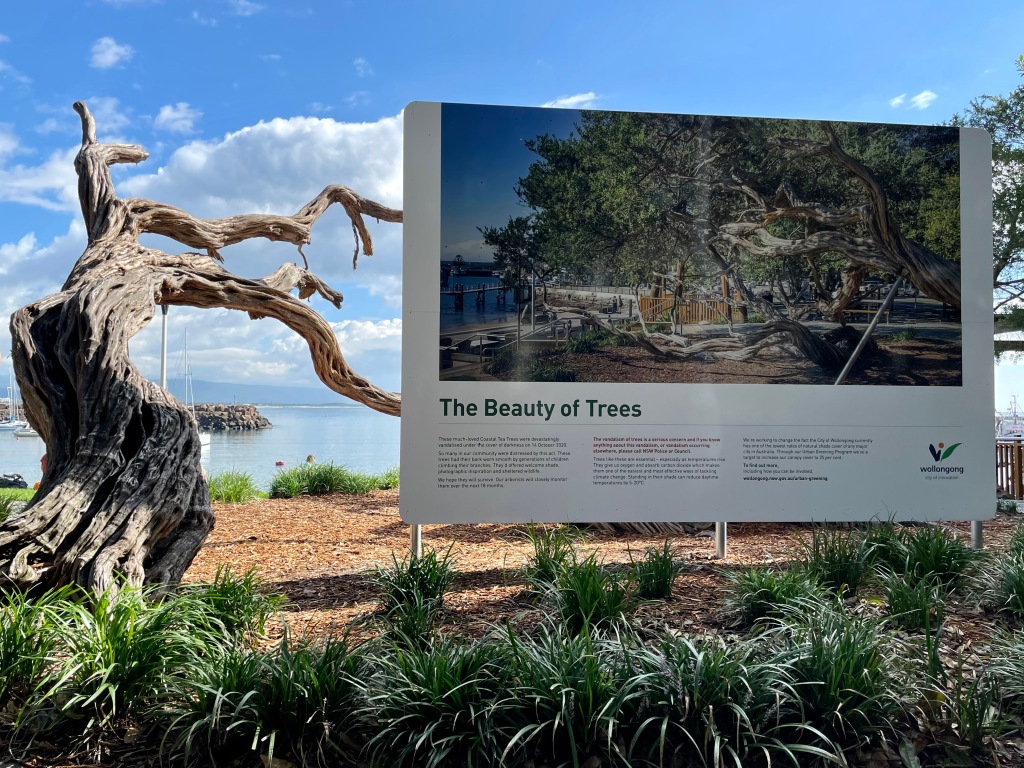Like just about any other human being, I have a strong attachment to my home and the landscape that surrounds me. I feel incredibly grateful to live in the city of Wollongong—part of the Illawarra region—and enjoy its distinctive, narrow coastline, backed by an escarpment that gives otherwise ignorant Westerners like me a sense of direction and orientation.
Although I like to think that most people respect their surroundings, there are some people who are simply out to ruin things for everyone else.
In 2020, a beautiful cluster of Coastal Tea Trees (Leptospermum laevigatum) at Brighton Lawn Park was savagely attacked by a still-unknown group of idiots. In response, the Wollongong City Council erected this sign next to the trees, which was roped off for a time prior to my image below. You can see one of the hacked trees and also Belmore Basin in the background.
I wish to highlight this wonderful public message by the council, ruminating not only our natural environment’s role in preserving biodiversity, but how we as humans connect to it and have a form a sense of collective identity. Here is the text from the council’s sign, which tells the story and significance of the area:
These much-loved Coastal Tea Trees were devastatingly vandalised under the cover of darkness on 14 October 2020.
So many in our community were distressed by this act. These trees had their bark worn smooth by generations of children climbing their branches. They’d offered welcome shade, photographic inspiration and sheltered wildlife.
We hope they will survive. Our arborists will closely monitor them over the next 18 months.
The vandalism of trees is a serious concern and if you know anything about this vandalism, or vandalism occurring elsewhere, please call NSW Police or Council.
Trees like this are essential — especially as temperatures rise. They give us oxygen and absorb carbon dioxide which makes them one of the easiest and most effective ways of tackling climate change. Standing in their shade can reduce daytime temperatures by 4–20°C.
We’re working to change the fact that the City of Wollongong currently has one of the lowest rates of natural shade cover of any major city in Australia. Through our Urban Greening Program we’ve a target to increase our canopy cover to 35 per cent.
To find out more, including how you can be involved, wollongong.nsw.gov.au/urgan-greening
Wollongong City Council published another piece about the incident on its community news site.
I had intended to write this piece some time ago, however simply forgot it amongst all the other tasks that fill my brain. I was reminded of it as we enjoyed a recent walk by the harbour; I thought about how tragic it could be that my future child may not be able to enjoy these magnificent trees, if the arborists’ efforts were to fail. The fact that someone did this is both disgusting and perplexing.
You may recall that late last year I wrote another blog post about noticing trees, only a short time before this vandalism took place. When it comes to the council’s claim that Wollongong has one of the lowest rates of natural cover of any major Australian city, I was shocked. When you look around Wollongong, you see trees everywhere: in the suburbs, along the coast and blanketing the entire escarpment. You often feel like you’re in the shade as well. The key term here, however, is the City of Wollongong—not greater Wollongong. Our city is indeed covered in trees, but the city centre is not.
I believe that even those who love and pay attention to the natural environment do start to become complacent about it, when in urban centres or central business districts. Visualising my city now, the majority of shade that is created in our city centre is from the ever-increasing number of high-rise apartment buildings, rather than trees. Why don’t trees line all of our footpaths and pedestrian zones, beyond the mall, which is our one real pedestrian zone? Why should trees be relegated to parks and the city’s outskirts? Our air would be cleaner, there would be more options for shade and people who live in the city centre could enjoy a more beautiful streetscape.
Our planet is quickly being covered by concrete, so how can we make people understand how trees can improve their physical and mental health, while fostering a sense of identity and place? Messages such as the council’s are a welcome (although overdue) start to addressing this problem.
